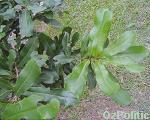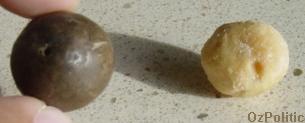|
Macadamia
Previous
Next
Up
Home
Macadamia integrifolia, Macadamia tetraphylla

Macadamia are native to the east coast of Australia and are one of the easiest trees to grow, requiring no maintenance once established. Since the invention of a machine to peel the nuts without breaking them, a large commercial industry has developed both here and overseas. Despite the prickly leaves they are a great tree for kids as they are easy to climb. I spent many afternoons as a child breaking open macadamia nuts to eat. I've never had to plant one as there have always been plenty around, but if you don't have one, you should!
Macadamia is a genus of eight species of flowering plants in the family Proteaceae, with a disjunct distribution native to eastern Australia (seven species) and Indonesia Sulawesi (one species, M. hildebrandii).
They are small to large evergreen trees growing to 6-40 m tall. The leaves are arranged in whorls of three to six, lanceolate to obovate or elliptical in shape, 6-30 cm long and 2-13 cm broad, with an entire or spiny-serrated margin. The flowers are produced in a long slender simple raceme 5-30 cm long, the individual flowers 10-15 mm long, white to pink or purple, with four tepals. The fruit is a very hard woody globose follicle with a pointed apex, containing one or two seeds.
The genus is named after John Macadam, who was a colleague of the botanist Ferdinand von Mueller who first described the genus. Common names include Macadamia, Macadamia nut, Queensland nut, Bush nut, and Maroochi nut; Indigenous Australian names include Kindal Kindal and Jindilli.
Cultivation and uses
 The nuts are a valuable food crop. Only two of the species, M. integrifolia and M. tetraphylla, are of commercial importance. The remainder of the genus possess poisonous and/or inedible nuts, such as M. whelanii and M. ternifolia; the toxicity is due to the presence of cyanogenic glycosides. These glycosides can be removed by prolonged leaching, a practice carried out by some Indigenous Australian people to be able to use these species as well.
The nuts are a valuable food crop. Only two of the species, M. integrifolia and M. tetraphylla, are of commercial importance. The remainder of the genus possess poisonous and/or inedible nuts, such as M. whelanii and M. ternifolia; the toxicity is due to the presence of cyanogenic glycosides. These glycosides can be removed by prolonged leaching, a practice carried out by some Indigenous Australian people to be able to use these species as well.
The two species of edible Macadamia readily hybridise, and M. tetraphylla is rare in the wild due to this. Wild nut trees were originally found at Mt. Bauple near Maryborough in SE Queensland, Australia. Locals in this area still refer to them as "Bauple nuts". The Macadamia nut is the only plant food native to Australia that is produced and exported in any significant quantity.
It's recorded that the first commercial orchard of Macadamia nut was planted in the 1880s by Mr Charles Staff at Rous Mill, 12 km south east of Lismore, New South Wales, consisting of M.tetraphylla.
The Macadamia tree does not begin to produce commercial quantities of nuts until it is 7-10 years old, but once established, may continue bearing for over 100 years. Macadamias prefer fertile, well-drained soils, a rainfall of 1000-2000 mm, and temperatures not falling below 10 °C (although once established they can withstand light frosts), with an optimum temperature of 25 °C. The roots are shallow and trees can be blown down in storms; they are also susceptible to Phytophthora root disease. Outside of Australia, commercial production is also established in Hawaii (the largest commercial producer), Brazil, California, Israel, Kenya, Bolivia, New Zealand, South Africa and Malawi.
The Macadamia nut's kernel is extremely hard to mine out of its shell (it requires about 300 psi or 2000 kPa to crack), but after some time in a warm and dry place the shell may develop big cracks. The nut can be opened then with a screwdriver, though the warm dry conditions also reduce the nutritional value of the nut. The shell is most easily cracked with a metalworking bench vice, but care must be taken not to crush the kernel in the process. The nuts can be opened simply by locating the seam line on the shell (This seam line can be located by looking carefully at the shell) and placing a knife blade on the line and tapping with a hammer. The shell will open and allow the nut to be removed whole. A safer and quicker alternative is to use a Ratchet style PVC pipe cutter. Place the cutter blade on the seam line and ratchet it closed - the shell will split and allow the nut to be removed. When nuts have dried for a period of time the kernel will fall out (with green or fresh nuts the kernel may stick in the shell). The nuts can also be smashed open with a hammer or heavy solid kitchen tool. Boiling the nuts for a few minutes in a pot until the nuts rise to the surface is also a good way as it causes the nuts to crack. Nuts of the "Arkin Papershell" variety, cultivated by retired stockbroker Morris Arkin, each have a blemish or small crack somewhere on the shell, and the shell will crack open readily if left for a few days, or if struck properly with a hammer.
Macadamia oil is prized for containing approximately 22% of the Omega-7 palmitoleic acid, which makes it a botanical alternative to mink oil, which contains approx. 17%. This relatively high content of "cushiony" palmitoleic acid plus macadamia's high oxidative stability make it a desirable ingredient in cosmetics, especially skincare.
Macadamia nuts are toxic to dogs. Ingestion may result in Macadamia nut toxicosis, which is marked by weakness with the inability to stand within 12 hours of ingestion. Recovery is usually within 48 hours.
The trees are also grown as ornamental plants in subtropical regions for their glossy foliage and attractive flowers.
Macadamia species are used as food plants by the larvae of some Lepidoptera species including Batrachedra arenosella.
|